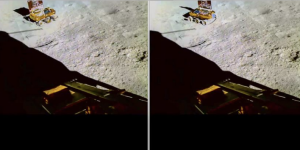NEW DELHI : Theoretically known information has now received two confirmations. The Chandrayaan-3 mission has verified the existence of sulphur on the lunar south pole region after on-site tests, a historical first that, according to scientists, could reveal information about the Moon’s formation and have a significant impact on space research.
On Thursday, the Indian Space Research Organisation (ISRO) announced that the Pragyan rover’s Alpha Particle X-ray Spectroscope (APXS) instrument had verified the existence of sulphur and a few other elements in the lunar south. Prior to that, ISRO reported on Tuesday that a different instrument, the Laser-Induced Breakdown Spectroscope (LIBS), had discovered sulphur in the area.
According to expectations, ISRO also revealed that the LIBS instrument had found traces of silicon, calcium, iron, titanium, manganese, aluminium, and chromium.
There are more than just solitary compounds among the elements discovered on the Moon. They are time capsules that contain cosmic history’s echoes. Such discoveries not only alter our understanding of lunar formations but also present opportunities for lunar exploration and settlement, according to Akash Sinha, who worked on the software for the Pragyan rover.
The professor of practise at Shiv Nadar Institution of Eminence in Delhi-NCR continued, “One common view is that the sulphur may be trapped within water ice, meaning that we might be on the verge of a monumental discovery: the physical presence of water ice on the moon.
In an old, undated NASA document, it was claimed that sulphur may be used to create lunar bricks or concrete by mixing it with lunar dirt. It’s interesting how this idea fits with China’s reported plans to test printing blocks from lunar dirt this decade for building a permanent moon outpost.
Scientists speculated that the discovery of sulphur could provide information about the Moon’s composition and volcanic past.
“Surface sulphur is produced by volcanic activity, indicating that the Moon has experienced significant volcanism in the past. We need additional data to get a clearer picture because the detection is just from one site, according to T. V. Venkateswaran, a scientist at Vigyaan Prasar, an independent institution run by the Department of Science and Technology (DST).
Sinha continued by saying that the discovery of sulphur signifies a tremendous advance in our understanding of the geology of the moon.
“Interesting possibilities about the origins of the Moon are opened up by the presence of sulphur, especially in an area where volcanic activity-a common source of sulphur-is noticeably absent,” he said.
The in-situ observations, according to astronomer Sandip Chakrabarti, surpass the capability of the instruments on the earlier Chandrayaan 1 and 2 orbiters to conclusively prove the existence of sulphur in the area.
The compositions reveal a lot of lighter metals like aluminium as well as a lot of sulphur and iron. Volcanic sulphur on the moon is a possibility. Only minute amounts of heavy metals, including chromium and titanium, were discovered. Chakrabarti, the head of the Indian Centre for Space Physics in Kolkata, said that they are in line with expectations.
He noted that these elements aren’t in their purest form and that processing is necessary before extraction.
“The Chandrayaan-3 findings have significant ramifications for lunar exploration. In addition to the appeal of space flight, the existence of these components provides a clear portrait of the Moon’s personality, Chakrabarti reflected.
The lightweight strength of aluminium, according to experts, may prove useful for upcoming missions, turning the Moon into a launchpad for additional space research. Discussions concerning the Moon’s potential as a centre for scientific inquiry may be fueled by calcium’s crucial role in biological processes. Chakrabarti was ecstatic by Pragyan’s input. The fact that Pragyan is actually sending the topsoil composition of the landing region, specifically Shiv-Shakti point, is encouraging. He also emphasised the importance of water, hydrogen, and helium for future space travel, survival, and energy production. “Right now, we are concentrating on survival on the Moon and not getting richer,” he continued. The ISRO has started a comprehensive research into the hydrogen’s presence.
Venkateswaran, who is also a member of the Astronomical Society of India’s outreach committee, stressed the rover’s importance in validating Chandrayaan-1’s 2008 discovery regarding hydrogen particles reflected by the Moon’s surface.
“We do require hydrogen and water in all of their forms. That would be a real accomplishment, Chakrabarti continued.
India became the first nation to set foot on the lunar south pole when Chandrayaan-3 landed there on August 23.


